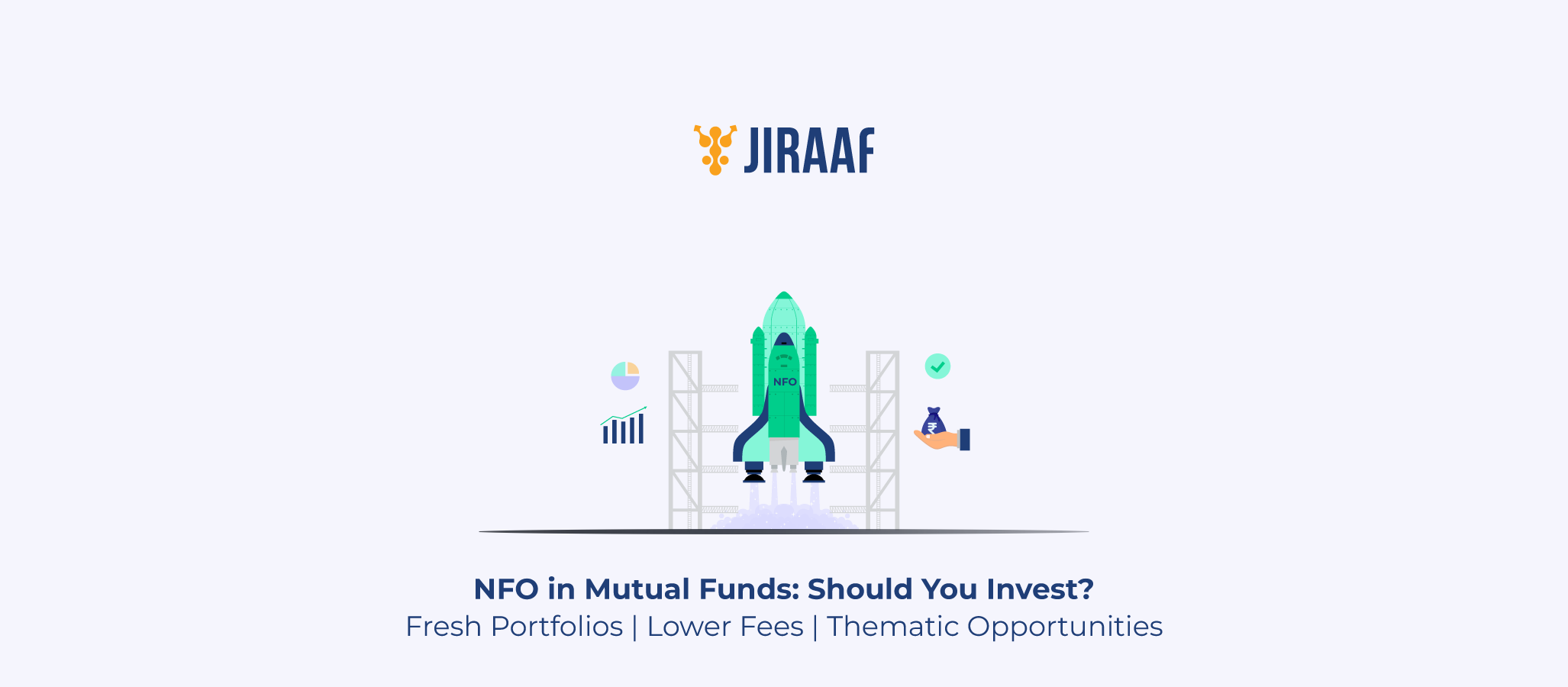Have you ever seen mutual fund advertisements promoting the ”new fund offers (NFOs)” and questioned whether it was worth investing? An NFO, similar to an initial public offering (IPO), lets you invest in a new mutual fund scheme at its initial launch price (usually around ₹10/unit). In 2024, India witnessed 239 NFOs, from thematic equity funds to innovative debt products.
Let’s discuss how NFOs work, their investment timeline, how can it benefit you if you decide to invest, and a side-by-side comparison with mutual funds.
What is NFO in Mutual Fund?
When a mutual fund company launches a new investment scheme, it follows the NFO process. A mutual fund is the investment that pools money from several investors and invests it in various classes of securities, including stocks, bonds, and other such assets, with the goal of earning consistent returns associated with your financial objectives.
An NFO is the starting point for a fund that is yet to start investing in the market. During the launch stage, the fund house invites you to deposit funds that will be used to create the scheme’s portfolio from scratch. An NFO’s subscription window normally lasts between 15 and 30 days. During this time, you can purchase fund units at a fixed price. This fixed pricing structure makes engagement available to first-time and all other kinds of investors.
NFO Full Form and How It Works
NFOs or new fund offers give you the chance to explore new segments or strategies or even emerging sectors to invest before the fund becomes open-ended and trades at a flexible net asset value (NAV). It can also help to diversify your portfolio by giving you exposure to new ideas and types of assets.
Professional fund managers handle the pooled money, which is then invested in various securities like equities, debt, and other assets that match the fund’s strategy and objectives.
Once the NFO period has ended, it normally takes about five days for the mutual fund company to distribute units to investors and launch the fund in the market. From there, you can purchase or redeem units based on the fund’s NAV. If your application for NFO units is denied owing to issues such as incomplete KYC, the amount deposited is reimbursed. Following the fund’s introduction, the fund manager actively manages the portfolio, making investment decisions that maximize your returns.
What is NFO Period in Mutual Fund?
When a mutual fund company introduces a new scheme, it is open to investments for a limited time—usually between 15 and 30 days. You can buy units at the initial price before the fund begins its regular functions. The NFO period that typically lasts several weeks, lets you subscribe through a mutual fund supplier or other authorized distributors. You invest within this specific time period, like an IPO. Following the NFO, the fund begins trading at market-linked NAVs.
Some NFOs provide unique strategies (for example, thematic funds such as the ICICI Pru EV Fund). Remember, NFOs are not necessarily “cheaper”—a ₹10 NAV does not mean it is undervalued.
SEBI requires clear start and end dates (for example, the SBI ESG Fund NFO is June 1-15, 2024).
Key features of NFO Mutual Funds
Minimum investment: NFOs often have a minimum investment requirement, which varies by the scheme you look at. To participate in the NFO, investors must meet this condition.
No track record: NFOs, unlike current mutual fund schemes, have no track record because they are freshly introduced. As a result, you cannot evaluate an NFO based on its past performance. Instead, you need to weigh other criteria such as your investing goal, fund manager expertise, and asset allocation approach.
Subscription period: NFOs have a fixed subscription term during which you can buy units. The subscription period is normally a few weeks long, giving investors enough time to study the fund and make educated decisions.
Price per unit: NFO units are normally sold at a predetermined price, or NAV which is typically set at ₹10 per unit. You can buy units at the fixed price throughout your subscription period.
Professional management: NFOs are managed by skilled fund managers that make investment decisions for you based on your goal and the market conditions, potentially increasing the likelihood of meeting your investment objectives.
Portfolio diversification: NFOs allow you to diversify your portfolio with new schemes, potentially increasing the risk-adjusted returns.
Is It Good to Invest in NFO Mutual Funds?
After considering and evaluating all the important factors that can influence your decision, you can choose to invest in NFO Mutual Funds through several platforms. These include asset management companies (AMCs), brokers, online trading accounts, and third-party investment applications.
Investing in NFO mutual funds have several benefits, some of which are:
- Early entry advantage: Investing in an NFO allows you to get in on the initial stages of a fresh new fund. Consider being one of the first investors in a thematic fund before it develops momentum. If the fund’s strategy is aligned with a thriving sector (such as AI or renewables), you can even benefit from its growth starting day one. However, “early” doesn’t always mean “better”—many NFOs need time to gain balance.
- Low expense ratio: To attract investors, NFOs occasionally open with lower costs (0.5-1% less than existing funds). For example, a new index fund could be set at 0.2% rather than 0.5% like another index fund. These savings accumulate over time, allowing you to keep more of your earnings. Just make sure the low fees aren’t a momentary promotion.
- Fresh portfolio, current opportunities: NFOs create portfolios from scratch, allowing fund managers to pick securities that are relevant to the current market. Consider it a new phone with cutting-edge technology—no heritage baggage to slow down its performance. For example, a 2024 NFO could invest heavily in semiconductor equities during the worldwide chip boom. But beware: “new” does not guarantee “win”.
NFO vs Existing Mutual Funds – What’s Better?
The main difference between an NFO and a mutual fund is that an NFO is the initial offering of a new fund, inviting investors to buy units, whereas a mutual fund is an established fund that is open for investment and has an existing performance history that you can analyze to make future investment decisions. Your overall financial goals can help you decide between the two.
NFOs offer a sense of a fresh portfolio, as in they are built from scratch based on the current market trends. They also come with lower expense ratios (ERs) to attract more investments. Lastly, you could invest at the initial NAV. However, they come with no past track record, which also means that past returns of similar funds don’t guarantee any victory. There is also a sense of market uncertainty. Many NFOs underperform in their first year. You can consider NFOs if you want to explore newer themes like artificial intelligence (AI) or electric vehicles (EVs) or even if the fund offers unique strategies not available in already existing options.
On the other hand, existing mutual funds are easier to judge because you can understand their past performance, they are more liquid, and you can easily get feedback on investor experience and assets under management (AUM) growth. You might want to go with existing mutual funds if you prefer a more reliable option which is less risky or if you have immediate liquidity needs.
Conclusion
While NFOs come with an appealing mix of new chances and lower costs, their lack of track record can raise uncertainty levels. Most investors prefer existing mutual funds because they have a proven track record and liquidity features. However, if you’re ready to take calculated risks to get more exposure to new themes or strategies, NFOs can be a strategic addition to your portfolio—as long as you thoroughly investigate the fund’s aim, management team, and market potential. Always thoroughly consider the benefits and drawbacks before investing the money you have worked for.
FAQs
What does NFO mean in mutual fund?
An NFO is the initial subscription offer for a new mutual fund. Beginners can invest in a new fund at its initial pricing, which is often set at a predetermined sum, such as ₹10 per unit. An NFO in mutual funds is a one-time offer for a new mutual fund that allows investors to buy units at a predetermined price. The fund is launched after the NFO period ends, and its NAV begins to vary in response to market conditions and the fund’s investments.
What is the full form of NFO?
NFO or new fund offer works similarly to other mutual funds, but with several key distinctions. Initially, it is open for a limited time, often 15 days, during which investors can subscribe to the fund. When this term expires, new investments are halted, and the units are distributed to subscribers.
Should I invest in an NFO mutual fund?
If you have a high-risk tolerance and want to explore new investments opportunities, NFOs could be appealing to you. However, if you value consistency, past achievements, and transparency, you may pick established mutual funds with a track record.
How long does the NFO period last?
Typically, the NFO period lasts for 15-30 days. When an NFO is open, money cannot be withdrawn since investors are buying units in a new mutual fund scheme. However, you can quit later by selling the units on the stock exchange or waiting until the maturity time ends.
What happens after the NFO period ends?
Once the NFO period is over, the fund house distributes units to investors within 5 working days at a predetermined NAV. The scheme then goes open-ended and begins trading at daily NAVs based on current market performance. Fund managers then invest the pooled funds into the chosen securities in line with the scheme’s objectives. Investors can purchase or redeem units at current NAVs; however, the original ₹10 price is no longer valid. The fund’s performance can now be tracked openly, allowing you to determine whether to keep or sell your investment.
Discover fixed income investments with Jiraaf, a SEBI registered online bonds platform that educates and brings access to a wide array of bonds. Sign up today to explore diversified fixed income investment opportunities to support your goal-based wealth creation journey. Start investing!




